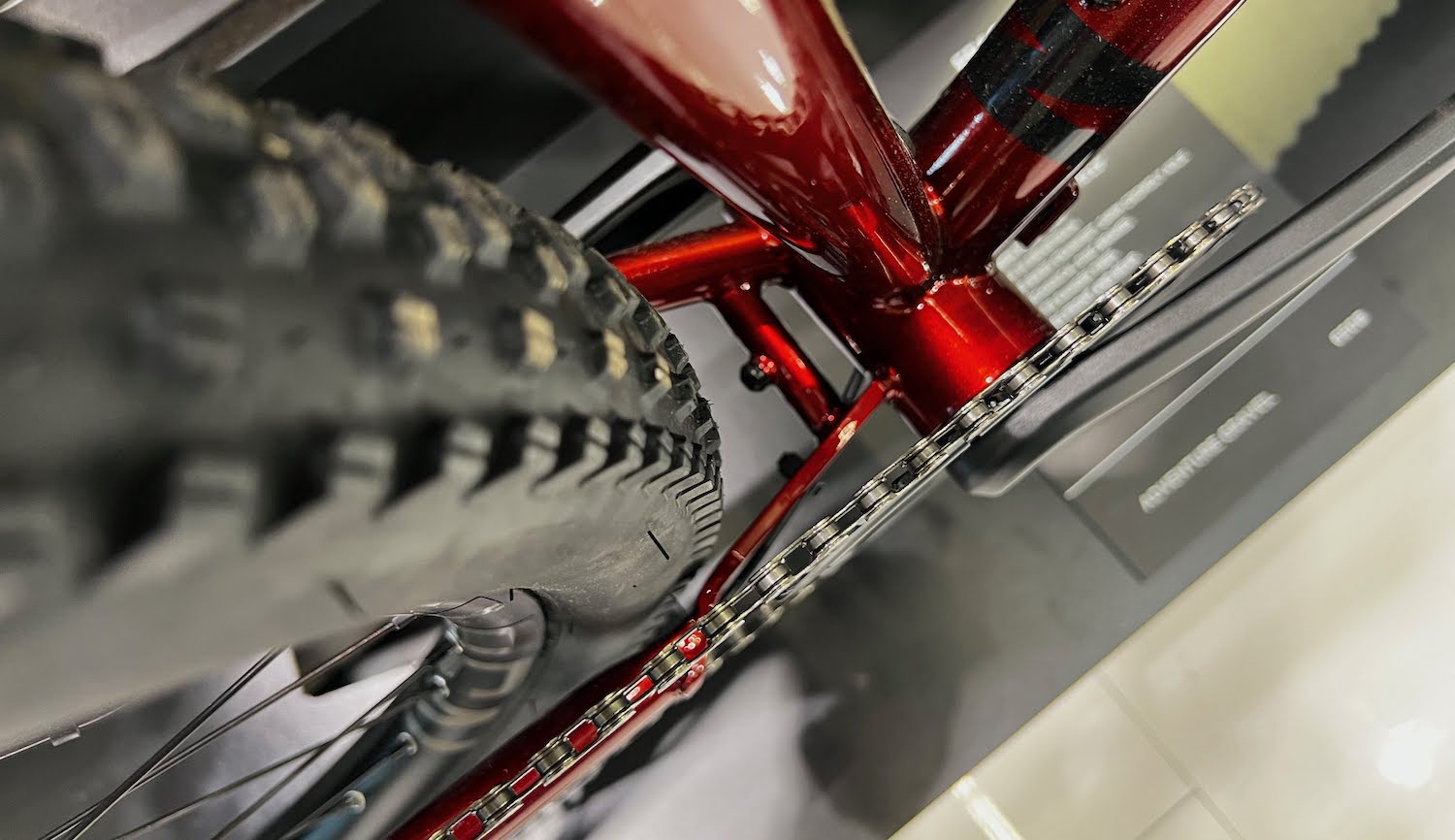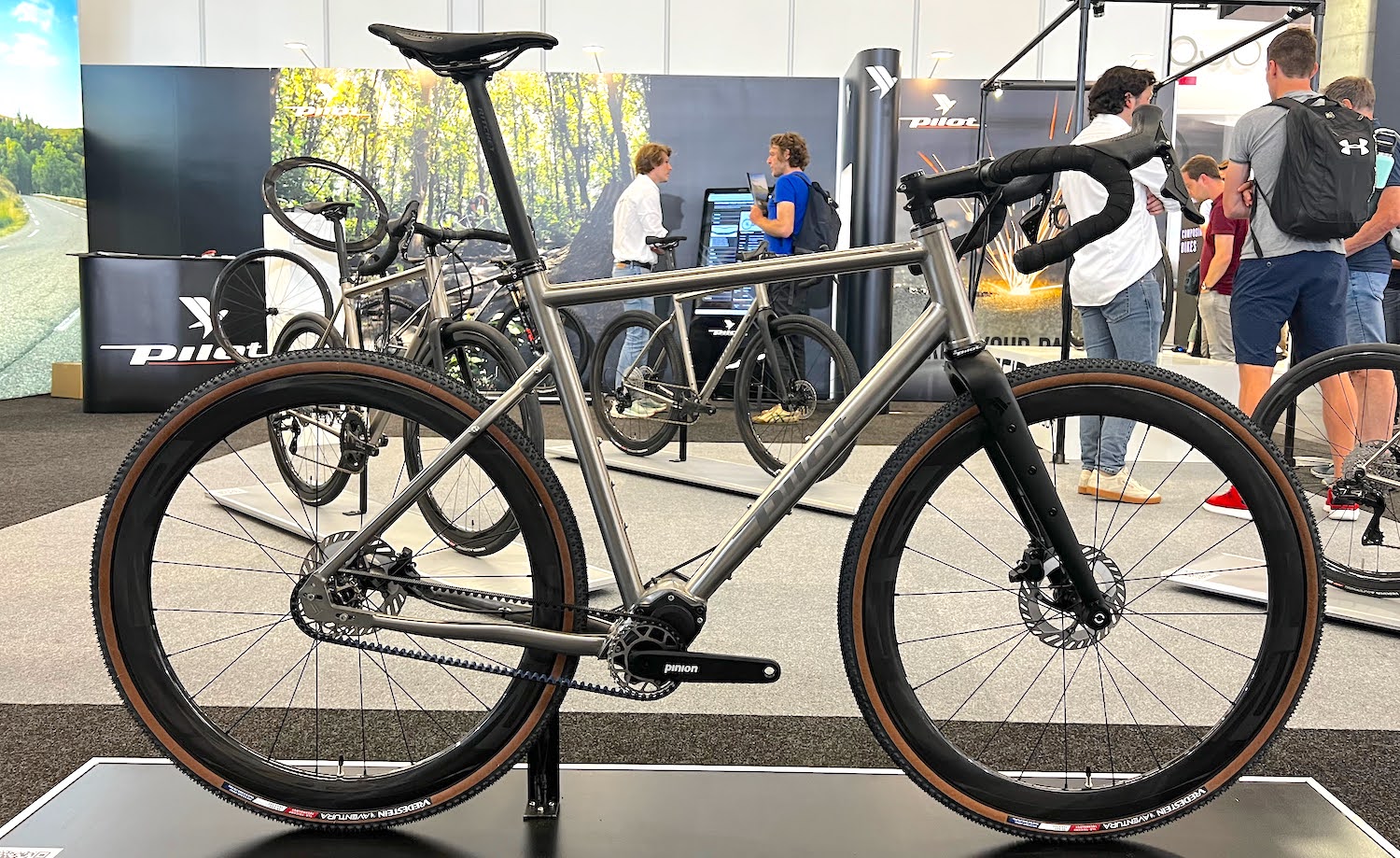Table of Contents
Gravel is one of the fastest-growing bike categories, and for good reason: these bikes allow you to ride on backroad networks that are quiet, peaceful, and a long way from the danger of cars and trucks.
Gravel bikes can handle the same uneven bike paths, cobblestone streets, and rough dirt tracks as mountain bikes – the key difference is their faster and more efficient riding position. And should you install some narrow slick tyres, you’ll even find them keeping up with road bikes. They are a true all-rounder.
In this article, I want to discuss four reasons why gravel bikes are about to get much better.
We’ll be looking at some new derailleur drivetrains, we’ll inspect the latest in tyre widths, we’ll talk about something a bit controversial (but it really shouldn’t be), gravel suspension forks, and finally, we’ll discuss some upcoming bike models with weather-sealed gearboxes and carbon drive belts.
Let’s start with the latest in derailleur drivetrains.
New Derailleur Drivetrains Will Make Hills Easier
A few years ago, I made a video that stated that hills are not harder than the flat. This statement sounds crazy, but you really can maintain the same power, cadence, and heart rate on both flat roads and steep hills – provided your bike has appropriately low gear ratios.
That’s the problem though. When you inspect most gravel drivetrains, and you calculate the maximum gradients the average person could comfortably ride up with that ratio – you quickly realise that gravel bikes are completely over-geared.
We can do the maths on this one. Most gravel drivetrains currently use a 1:1 climbing gear. Let’s say the average cyclist is 80kg/176lb and can output 150 watts of power for a sustained period. At a slow 60RPM cadence, the maximum gradient our cyclist can comfortably ride up is just 6.6%. Gravel roads regularly exceed this gradient, so it’s no wonder most people find hills hard!

The good news is that gravel bike drivetrains in 2024 are finally available with suitably low gear ratios. On a bike fitted with a SRAM Apex Eagle drivetrain, and a 38T front chainring, our average 80kg/176lb rider can now comfortably ride up 9.4% gradient – which is a massive 30% increase in grade.
The latest Shimano GRX 1X drivetrain is not far off. With a similarly large rear cassette and 38t chainring, our rider can climb up a 9.2% grade.
When it comes to 2X drivetrains, Microshift has you covered with their new Sword groupset. The crankset offers a 29-tooth front chainring, and the cassette maxes out at 38-tooth. This would get our rider up an 8.9% hill, which is a 25% increase in grade over what current gravel drivetrains offer.
Another big gravel bike improvement is the changes to tyre clearance.
New Tyre Widths Will Provide More Comfort and Control

Gravel bike tyre clearances are currently increasing. It was not long ago when 40mm wide tyres were the maximum size you could fit in most gravel bikes. Nowadays, 50mm is popular, and some bikes will clear as wide as 60mm (2.4”).
Wider tyres are an improvement because they afford more comfort, grip, and control over narrower ones, as well as being less susceptible to pinch flats. They also allow you to experience significantly less body fatigue on longer rides.
When comparing 42 and 50mm wide Soma Cazadero tyres on a fast gravel road, our tests found a 9% reduction in vibrations at the handlebar with the wider tyre. The difference to a Rene Herse 44mm tyre was even greater – we found a 23% reduction in vibrations!
Wide tyres with the right rubber composition will undoubtedly keep you comfortable, but wait – don’t they have a lot of rolling resistance?
The fascinating thing is that when you move to wider tyre sizes, the rolling resistance doesn’t increase as much as you’d think. This is because it’s the rubber compound and sidewall design of a tyre that are usually the biggest factors when it comes to rolling speed.
By conducting rolling resistance tests outside and on special measurement rigs, we can find 37mm wide touring tyres that have more rolling resistance than 100mm wide fat bike tyres. Yes, you heard that right!
The fastest tyres use thin sidewall casings constructed with compounds that have what is known as a low ‘hysteresis’. A tyre with a low hysteresis compound will deform and go back to its original shape with very little energy loss.
A “super ball” is an example of a product with low hysteresis – when you drop it from a given height it will bounce almost as high as it loses little energy with each bounce. Tyre compounds work very similarly.
Of course, there is an aerodynamic argument against using wider tyres. But YouTuber Dylan Johnson has gone to the wind tunnel and shown that it’s only 2-3 watts more resistance per 5mm extra width at 35kph/22mph. That’s almost certainly a penalty worth taking if you’re primarily riding on gravel.
Another improvement to gravel bikes is suspension fork compatibility.
New Suspension Fork Options Will Improve Performance
Gravel bikes are perhaps the only vehicle designed for off-road terrain without some sort of suspension element. But that’s about to change, as new bike models are becoming available with suspension forks – right now there are 18 of them in the Bikepacking Bike Buyer’s Guide, and the number is growing.
The biggest advantage of a suspension fork is the improved front tyre traction, which not only helps with cornering grip but also braking performance. This will ultimately give you more confidence and control on rougher roads.
In addition, you can expect less hand fatigue and a comfort improvement too. We measured 6 to 11% less vibration at the handlebar in our comparison tests between a HiRide 20mm suspension fork and an Open WI.DE rigid carbon fork – that’s over obstacles that simulate riding on fast gravel roads, and over edgy rocks.
Keep in mind that vibration exposure is greater on longer rides, so the more time you spend on your bike, the more comfort you have to gain with a suspension fork.
You might even go faster too. Geoff Kabush conducted some suspension fork testing on his gravel bike and found his speeds increased by 4.0 to 4.7% over a rigid fork when pushing the same power output. While these tests are not super scientific (and ultimately funded by Fox suspension) it’s feasible to see these kinds of speed increases on rougher roads.
The downsides of suspension forks include around 800 grams of added weight, the necessity for regular servicing intervals, a less aerodynamic design, and arguably worse bike aesthetics.
That said, a fork like the HiRide Sterra hides the hydraulic damper in the head tube away from the elements, which not only increases service interval lengths, but maintains good aerodynamics and the sleek gravel bike look. And when you don’t need the suspension travel, you can simply press the lock-out button and make it rigid.
Even if you don’t care for suspension, bike designers are currently decreasing the head tube lengths of their frames, while simultaneously increasing the rigid fork lengths. This allows one frame to suit both fork types; all you need to do is choose what you like best.
New Gearbox Options Will Reduce Bike Wear and Maintainance
Let’s finish this article with the latest in gearbox and belt drive gravel bikes. This is another fast-growing subcategory in my buyer’s guides and will be beneficial to many cyclists.
Gearboxes and internal gear hubs are weather-sealed from the elements, resulting in a super long-lasting, and ultra-low maintenance drivetrain. Pair them with a belt drive, and you won’t need to degrease or lubricate a chain again.
These gear systems are much less susceptible to damage than a derailleur, they never have to be tuned or adjusted, and will usually last a lifetime too – one Rohloff hub owner has famously exceeded half a million kilometres on his hub!
In addition, the gear range is wider than any gravel drivetrain, and the gear shifts can be made anytime, including while stationary.
The gearbox pick of the bunch on a gravel bike might just be the new Pinion Smart Shift system, which uses electronic drop bar shifters to ensure quick and easy gear shifting.
The coolest thing about this drivetrain is that it times your gear shifts so that you never have to back off on your pedal power when you change gears. It can also be configured to automatically change your gears based on your speed, which will always ensure you’re pedalling at the perfect cadence.
The downside to gearbox gravel bikes is the weight penalty of 1.0 to 1.5kg, the high price, and a reduction in drive efficiency of between 2-6%, depending on the gearbox or gear hub model.
If these drivetrains have piqued your interest, you can find in-depth information about gearboxes, internal gear hubs, and belt drivetrains on my YouTube channel or in the Bicycle Drivetrains category of this website.
Summary
Due to several recent advancements, gravel bikes are about to get much better.
Expect to see gear ratios that are better suited to steeper terrain, wider tyres for more comfort and control, compatibility with high-performance suspension forks, and models with ultra-low maintenance gearbox drivetrains.
If you’d like to learn more about gravel bikes, see all the current models available, and compare them side-by-side, make sure to check out my Bikepacking Bike Buyer’s Guide.






